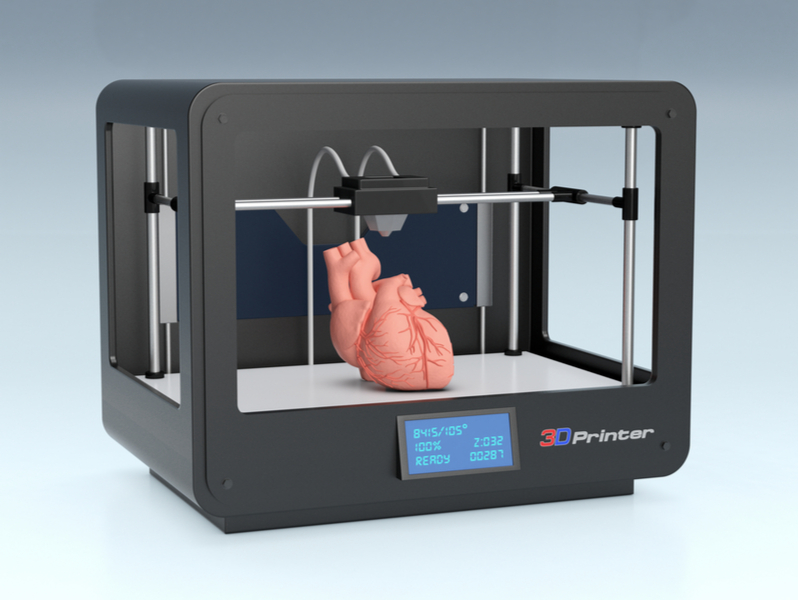One craze that has been developed in this 21st century is ‘3D printing’. While most of us couldn’t even afford 2d printers, 3D printers and its technology widened its structure from printing small toys to even gigantic buildings and now ‘human organs’ ready for transplantation.
No more angst of tissue damage, bone breakage or heart failure as you could have another one!
3D Printing for Organ Transplants
The global organ shortage deceases people before transplants are available and in India 500,000 people died due to organ unavailability in 2019. The shortage leaves thousands or lakhs of people in the waiting list. In motive the reduce the numbers, researchers have now formulated 3d printing biological organs, simply called ‘3D Bioprinting’.
Bioprinting refers to 3D printing the biomaterial (material for printing) in layers to build complex bodily structures like skin, bones, corneas and even heart. For any organ transplant, one should match with your bodily cells, only if, the patient survives. Reasoning to this, the organ to be printed is fed with requisite cells taken from a patient – or, if this isn’t possible, adult stem cells can be used – and cultivated into a bioink to ‘print’ an organ.
These are held together through some sort of dissolvable gel or collagen scaffold which can support the cells and mould them into the correct shape.
Printing body parts may well be the next step in organ transplantation – harvesting stem cells from a transplant recipient and printing them into a replacement organ could help bypass complications associated with organ transplant such as long waits for a suitable donor or immune rejection of the new organ.
So, what are all the organs, researchers have attempted to bioprint?
Bones
Researchers from Swansea University, UK developed a bioprinting process for making artificial bone matrix, using durable, regenerative biomaterial. Currently, for severe bone fractures, ‘bone grafting’ replacing missed or damaged bones with synthetic, cement-based materials is performed, that often have inappropriate mechanical integrity & forbids tissue formation.
While this bioprinted bones can be a ditto of missing bones, rendering integrity, flexibility and tissue formation.
Heart
A group of scientists at the American Friends of Tel Aviv University have 3D printed a fully-vascularised heart using fat tissue cells from a donor.
The fat cells were partially cultured and reprogrammed into heart cells. The entire heart structure is present with all cells, blood vessels, ventricles and chambers. The structure was based on medical images of the donor patient’s own heart.
The technology is still in its early stages – the heart the researchers have printed is the size of a rabbit’s heart and is unable to pump any blood. The researchers hope to test these printed hearts in animals once they have worked on rescaling the organs and getting them to beat.
Tissue
Traumatic events like vehicle accidents, workplace injuries or violence put away 22.6 million people requiring neurosurgical interventions, normally a tissue damage.
The disconnected nerve ends could be realigned and stimulate the nerve growth in current surgical techniques, but the result is not guaranteed or the function is never as before.
Read this: Selfie could be used to detect heart disease – AI study reveals
Using 3D bioprinting technique, a research team created a porous structure made of the patient’s neural cells and a biomaterial to bridge an injured nerve. We used alginate — derived from algae — because the human body does not reject it.
While this technique has not yet been tested in people, once refined, it has the potential to help patients waiting for tissues and organs.
Cornea
The World’s first synthetic cornea transplant was carried out on January 11 at the Beilinson Hospital in Israel. Being granted approval in 2020 to move forward with clinical tries to implant artificial synthetic cornea, the Israeli startup CorNeat Vision triumphed by regaining the sight of a 78-yr old blind man, who had lost his vision, 10 years back.
Skin
Skin transplant for replacing burned wounds with fresh skin drives it easy than before with traditional skin grafting, where they harvested healthy skin from an unburnt part of a patient’s body. This limit, if the burn is spread all over the body. However, in this printing technique, a patch of skin only 10% of the size of the burn can be used to grow enough cells for 3D printing. A scanner is used to determine the size and depth of the wound, and the printer then takes this information and prints hypodermic, dermic, and epidermic skin cells at the corresponding depths to cover the wound.
As trials around this technology move forward, the research team is hoping to see if stem cells from amniotic fluid and placentas are as effective as patient skin in healing these wounds.

